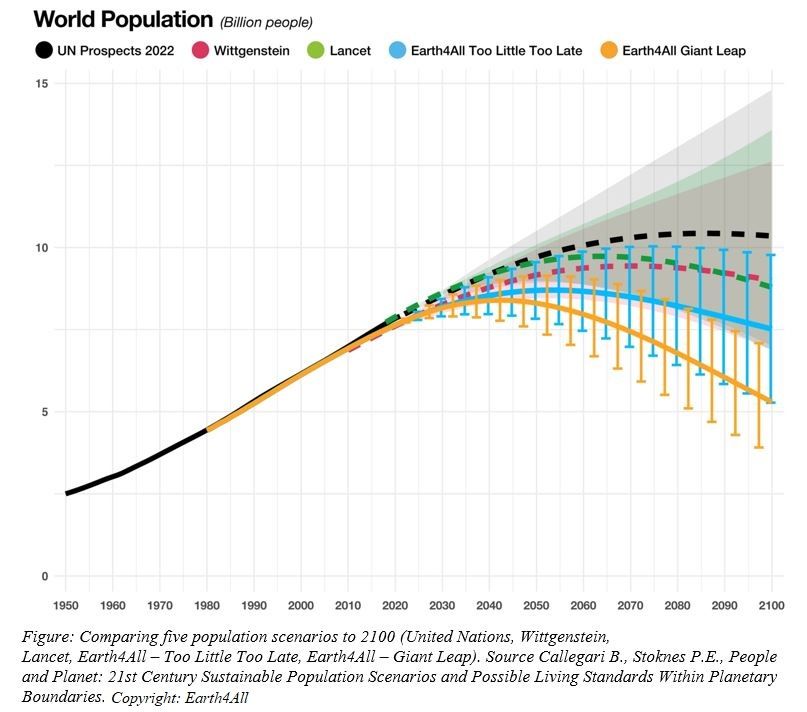Population growth does not represent a serious threat to sustainable development. In fact, the world population may peak much lower than anticipated, and it is the consumption of the world’s richest 10% that will continue to be the biggest obstacle to widespread human development.
An easy way to generate a long and heated debate is to bring up the subject of world population. The passionate arguments that Thomas Malthus caused in the nineteenth century are well known. by warning that, in the absence of population control measures, the world’s population would grow exponentially at a rate that would outpace advances in agriculture and lead to recurring bouts of famine and disease. Industrialization would help postpone the crisis, but not forever.
These arguments were still simmering in the 1960s, when Paul and Anne Ehrlich added fuel to the fire with their bestseller The population bomb (The Population Bomb). His fears were reasonable, considering the data presented. By 1975, the global population doubled to 4 billion in less than 50 years. AND just doubled back: last November we reached 8 billion human beings. This raises the question: will the population double again to 16 billion?
The answer is a categorical “no”. In fact, the world population will not even come close to that level, due to a demographic paradigm shift that has been occurring for the past half century. The population growth rate reached its boom in the 60s of the 20th century and since then it has been falling at a constant rate. All over the planet, women are choosing to have fewer children, and the fertility rate global average is now a little less than two children per woman.
Of course, this number hides large geographic disparities. The number of children per woman is less than two in places like Germany and Japanbut it is much higher in most of the low income countries, especially in those with fragile states. Even so, the United Nations esteem that the world population could reach between 10 and 11 billion in the current century, before slowly beginning to decline. That’s still a huge number of mouths to feed, but it’s nowhere near 16 billion.
Furthermore, our own analysis in a new report titled People and Planet: 21st Century Sustainable Population Scenarios and Possible Living Standards Within Planetary Boundaries (People and the Planet: Sustainable Demographic Scenarios for the 21st Century and Possible Living Standards Within Planetary Boundaries), produced for the Global Challenges Foundation in Stockholm, concludes that by the middle of this century the global population could reach a maximum level much less, about 9 billion. And if the world invests more in economic development, education and health, the global population could be reduced to levels where every person on Earth has sustainable access to clean energy, shelter, food and water. The bomb will have been defused, allowing each and every one of us to have a good life within the limits of the planet. That should be cause for celebration.
Our projections come from a new system dynamics model called earth4all, which allows exploring two economic and population scenarios in this century. In the first scenario, the world economy follows a path similar to that of the last 50 years, many of the poorest countries eventually rise out of extreme poverty, and the global population peaks at 8.8 billion in mid-century before down to 7.3 billion in 2100.
In the second scenario, which we call the “Giant Leap,” the global population peaks at 8.5 billion around 2040 and drops to just 6 billion by the end of the century. To do so would require unprecedented investments in poverty alleviation and human capital, along with radical shifts in food and energy security policies, inequality, and gender equity. In this potential future, extreme poverty would be eliminated within a generation (by 2060), with a marked impact on population trends.
Traditional population projections often have difficulty connecting population growth with economic development. And yet we know that rapid economic growth in low-income countries has a huge impact on fertility rates, which drop when girls have access to education and the women turn more economically empowered through access to paid jobs, better health care and family planning methods. When we incorporated these factors into our projections, population growth slowed markedly.
But our findings came with a big caveat: to achieve the Great Leap, governments in low-income countries must fully commit to driving economic development underpinned by large investments in education, rather than pursuing purely extraction-driven growth. of natural resources.
Moreover, it is not enough to defuse the population bomb to reduce the risk of a civilizational collapse. When we investigated the link between population and planetary boundaries, we found that—contrary to popular myth—population size is not the main reason humanity is pushing those boundaries (reflecting in issues like climate change). Instead, the main driver is consumption by the top 10%, a cohort with an extremely large material footprint.
The great problem of humanity is not the population, but the consumption of carbon for purposes considered luxury and the disappearance of the biosphere. Where populations are growing fastest, they have extremely small environmental footprints compared to countries that reached their population peaks decades ago. If resources were distributed more fairly, the current global population would already be enjoying conditions above the minimum level set by the UN, and without the need for major changes in development trends.
People and Planet offers a hopeful perspective on the global population. Our findings challenge the common misconception that population growth is the main cause of overstretching the planet’s boundaries. In reality, it is the richest in the world who are pushing us over the precipice.
Through systemic economic change, we could still provide a good life for all within planetary boundaries. Our hope is that our report will lead policy makers and implementers to reassess the impact of consumption patterns, prioritizing equitable distribution over economic growth per se.
© Project Syndicate, 2023. www.project-syndicate.org







![[Img #74683]](https://thelatestnews.world/wp-content/uploads/2024/12/The-main-mistakes-to-avoid-when-betting-on-electronic-sports-150x150.jpg)







